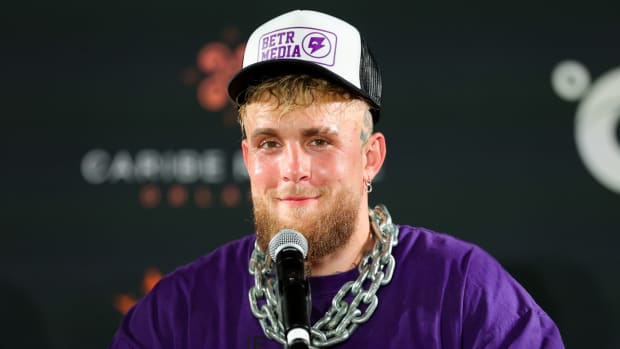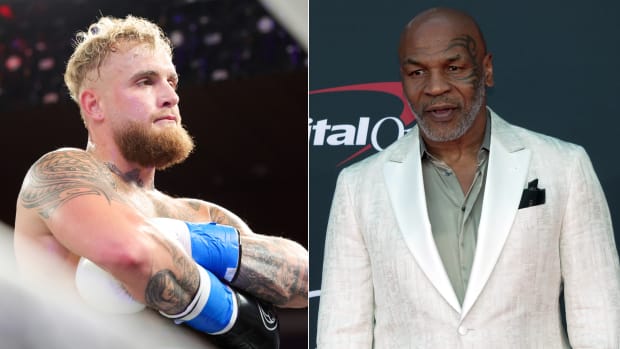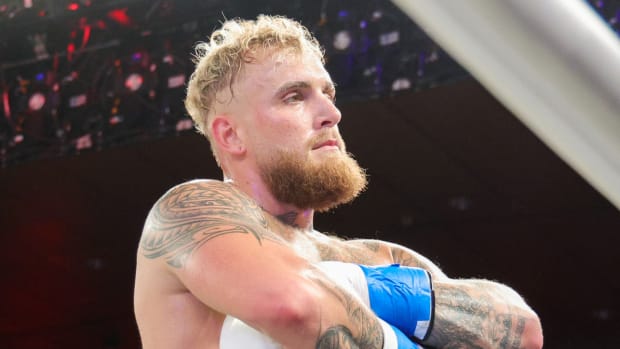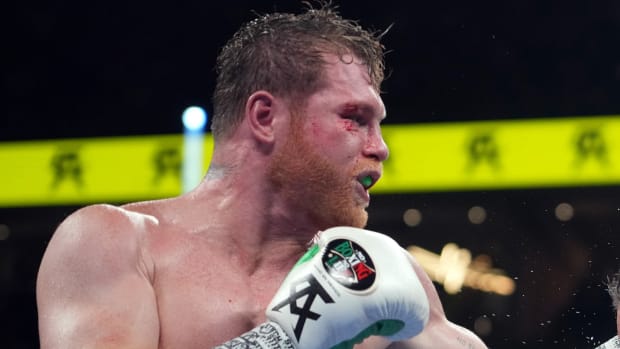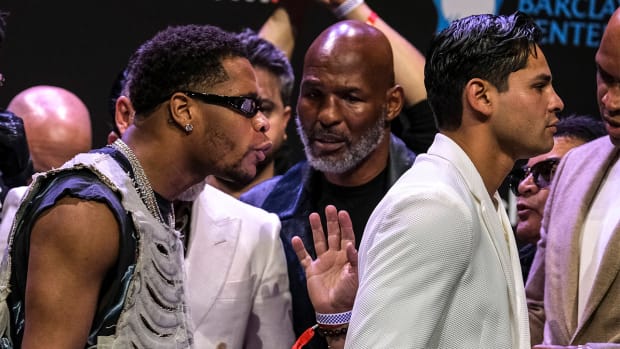12 Rounds: Manny Pacquiao's Next Fight, Mayweather's Retirement and More
The legend of Manny Pacquiao grows, the rise of Teofimo Lopez slows and a pair of heavyweights made strong cases for more significant fights. On a busy weekend in boxing, with plenty of consequences.
1. Pacquiao turns back the clock. Two years ago, Pacquiao looked finished. He lost a close fight to Jeff Horn—and even those that believe he won found his performance unimpressive—and his time at the top was believed to have run out. Undoubtedly, Pacquiao could still make some money off his name, but it seemed unrealistic to believe he could beat a top–level opponent.
Fast forward to today and Pacquiao is once again a top fighter in the 147-pound division. Against Thurman—ten years Pacquiao’s junior and himself once considered the best welterweight in the world—Pacquiao looked sharp, out throwing Thurman (57-48 per round, per CompuBox), out jabbing him (82-18) and scoring the only knockdown of the fight. You could make grain-of-salt arguments for Pacquiao’s last two wins, a knockout against a washed Lucas Matthysse and a decision win over Adrien Broner, who didn’t come to fight. Not this one. Thurman is an impressive talent with bona fide welterweight power. He was fresh, coming off a win of his own last January. Pacquiao has had some impressive wins in his quarter century career, but given his age (40) and opponent, this one ranks right up there among the best.
2. What to make of Thurman?Before the fight, critics wondered if Thurman, 30, was the same fighter who ascended to the top of the 147-pound weight class with wins over Shawn Porter and Danny Garcia, or if a two-year layoff, a marriage and myriad outside interests had sapped Thurman’s desire to be great. After … it’s unclear. Thurman didn’t embarrass himself. He landed 193 punches on Pacquiao—the most Pacquiao had absorbed in the 43 fights tracked by CompuBox—including a crushing right hand in the 11th round that would have put many opponents on the deck. But he was outworked by Pacquiao and, by his own admission, beaten by a man in better condition. Those issues will need to be addressed moving forward. Fortunately, Thurman’s connection to Al Haymon’s PBC offers him a deep roster of top welterweights to rebuild against. He will be back.
3. What’s next for Pacquiao?The natural next opponent is the winner of the September 28th unification fight between Porter and Errol Spence. Spence, fresh off a decisive decision win over Mikey Garcia, will be a favorite in that one, as he continues his climb up the pound-for-pound rankings. But think about the kind of story Pacquiao could author in the twilight of his career? If he somehow beats Spence, he would have three pieces of the welterweight crown. The fourth? That belongs to Terence Crawford, the cornerstone fighter in Bob Arum’s stable. A Pacquiao-Crawford fight in 2020 would be huge. Pacquiao would be reunited with his former promoter with a chance to knock off the man that replaced him as Arum’s top guy. It’s a potential million-plus buy pay per view that would afford Pacquiao the chance to finish his career as the undisputed welterweight champion and arguably the best fighter in the sport.
4. Will Floyd Mayweather come out of retirement? Sitting ringside on Saturday was Mayweather, attending in his nominal role as co-promoter of the show. There have been no indications that Mayweather, 42, is interested in coming out of retirement for a Pacquiao rematch—his top advisor, Leonard Ellerbe, has sworn that he will not—but Pacquiao’s performance at least created the opportunity for it. The first fight broke every boxing revenue record and while a rematch wouldn’t do as big business, it’s easily the most lucrative fight that could be made. Mayweather has shut the door on returns before, only to come back when the money was right. Is there a dollar figure out there that could get Mayweather back in?
5. The Takeover stalls. On Friday, Teofimo Lopez—SI.com’s 2018 Prospect of the Year—outpointed Masayoshi Nakatani, picking up his 14th win and securing a title fight against Richard Commey later this year. There are the positives. The negatives were that Lopez, 21, looked unimpressive, struggling at times dealing with the nearly six-foot Nakatani’s superior height and unable to land the type of fight changing power shots he has become known for. Credit Nakatani—he’s tough, skilled and pressed the action. But Lopez described his performance as “horrible” and it’s clear he needs to figure out how to fight taller opponents. That won’t be a problem at 135-pounds—Commey, like Lopez, is 5’8”—but as Lopez moves up in weight, these type of opponents will be there.
6. Should Lomachenko be off the table?If Lopez beats Commey, the plan has been for Lopez to challenge Vasyl Lomachenko, boxing’s pound-for-pound king who will attempt to unify three pieces of the 135-pound title against Luke Campbell next month. Speaking to SI.com after the fight, Arum, Lopez’s promoter, questioned if that was still the right move. Flaws in Lopez may have been exposed, but there is little downside to putting him in with Lomachenko anyway. A Lomachenko fight will be Lopez’s last at 135-pounds, and the opportunity to test his skills against the very best before moving up could be enormously beneficial. Lomachenko is a smallish lightweight, so the chances Lopez could get badly hurt are minimal. And a loss to Lomachenko at a time in his career where most fighters are sniffing that type of challenge will not diminish Lopez at all.
7. Danger of boxing.On the undercard of Lopez-Nakatani, we were reminded of just how dangerous a sport boxing is. In a battle of undefeated prospects, Subriel Matias stopped Maxim Dadashev, with Dadashev’s corner throwing in the towel after the 11th round. On his way to the dressing room, Dadashev collapsed. He lost consciousness on the way to the hospital, forcing the ambulance to re-route to a more equipped trauma center. He underwent a two-hour procedure to address a brain bleed. A portion of his skull was removed. He was placed in a medically induced coma.
Fighters understand the risks they take when they step in the ring, but the reality of those risks is terrifying. SI.com recently chronicled the recovery of Daniel Franco, a former prospect who had a similar injury following a knockout loss in 2017. Franco’s career ended that night, and he is slowly piecing his life back together. Here’s hoping Dadashev can do the same.
8. Dillian Whyte makes his case. Does any heavyweight—champion or otherwise—have a more substantive résumé than Whyte? Consider: Since losing to Anthony Joshua in 2015, Whyte has won 10 straight fights, the latest a decision win over previously undefeated contender Oscar Rivas. Whyte now has two wins over Dereck Chisora—more on him below—and a win apiece over Joseph Parker, Lucas Browne, Robert Helenius and David Allen. With no titleholder willing to voluntarily face him, Whyte has cleaned up on the second tier contenders. The win over Rivas made Whye the mandatory challenger for Deontay Wilder’s WBC title—a fight that allegedly must happen by May, 2020. Whyte has flaws—his conditioning wasn’t great against Rivas and a ninth-round knockdown offered further evidence of a shaky chin—but he’s doing what you want fighters to do. He takes on all comers and he proves himself worthy of a title shot by beating up on worthy opponents. Here’s hoping he gets his shot next year.
9. Derrick Chisora rolls. There’s something admirable about Chisora. He’s got nine losses on his résumé, but every time he loses, he dusts himself off, gets back in the ring and works his way back to relevance. On Saturday, Chisora blasted out former title challenger Artur Szpilka, picking up his second win in a row following a knockout loss to Whyte last December. Chisora has been on the wrong end of some close decisions (Whyte, Kubrat Pulev and a absolute robbery against Helenius, in 2011) but he always bounces back. The win over Szpilka sets Chisora up for a crossroads fight against Parker, which will take place before the end of the year.
10. Cassius Chaney KO. The highlight of the weekend came courtesy of Chaney, an undefeated heavyweight who faced Joel Caudle on the undercard of Lopez- Nakatani. Chaney battered Caudle in the first round, hunting him around the ring. Towards the end of the round, Chaney battered Caudle with a combination, finishing it with an uppercut. A wobbly Caudle stumbled towards the ropes and toppled head first out of the ring. Remarkably, Caudle was able to get back in—he extended his hands before he hit the floor, bracing his fall—but Chaney finished him off moments later.
Chaney is an interesting prospect. He’s huge (6’6”) with good power. At 32, he will need to be moved quickly. Main Events matchmaker Jolene Mizzone told SI.com she would like to match Chaney with Otto Wallin, another undefeated heavyweight prospect. A Chaney-Wallin matchup would be compelling, either as a co-main event on a big show or headlining a smaller one.
11. An Usyk update. It has been nine months since we last saw Oleksandr Usyk, SI.com’s 2018 Fighter of the Year. The former undisputed cruiserweight champion was set to make his debut at heavyweight debut last May, against Carlos Takam, only to have a biceps injury put him on the shelf. Usyk’s manager, Egis Klimas, told SI.com that Usyk is on the mend and he will likely return either September 28th or October 12th, likely against Takam. If Usyk gets through Takam, he could face the winner of Parker-Chisora in 2020.
12. Fox and Bud Crawford. A broadcasting note: Fox has done some really nice things since its full–fledged entry into boxing earlier this year. The network has invested considerable resources, from studio shows (Kate Abdo is a strong interviewer in these spots) to promotion during its biggest events, including high profile NFL games, baseball and the World Cup, not to mention on its various daily programming. It’s involvement has unquestionably been good for boxing.
But Saturday night illustrated a beef many boxing fans have with the broadcasts: That Fox operates like only Fox-connected fighters exist. During the pay-per-view, Fox put up a graphic under the banner “welterweight champions.” It showed Spence, Porter, Thurman and Pacquiao. Nevermind that Pacquiao, before beating Thurman, wasn’t really a champion; the secondary title Pacquiao held was worthless. But the list excluded Terence Crawford, a recognized titleholder widely regarded as one of the top three best fighters in the sport. It’s not the first time Fox has excluded Crawford from one of these lists, and the omission drew reactions from several fighters on social media, including Crawford.
Look: No one is saying Fox should promote Crawford, who works with Top Rank and fights exclusively on ESPN platforms. And everyone in boxing knows that Crawford won’t face any of the top PBC fighters until someone emerges from the Pacquiao/Spence/Porter mini-tournament going on over on that side of the street. But leaving Crawford off a list like that is just petty. This was a PPV broadcast—does anyone really think a person plunking $75 to watch a welterweight fight isn’t aware of Crawford?
Boxing will grow only when the best consistently face the best, regardless of promotional or network affiliation. PBC can’t flourish only by making fights in-house, just like Top Rank can’t do it alone at ESPN, nor can Eddie Hearn and Oscar De La Hoya insulate themselves at DAZN. There has to be cross promotion. There has to be network compromise. Pretending that fighters outside of your universe don’t exist is simply counterproductive.
Chris Mannix is a senior writer for Sports Illustrated and on-air personality for DAZN.
